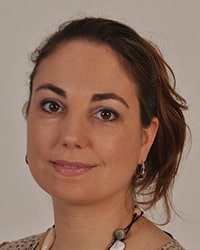 |
Christine FrayretUniversité de Picardie Jules VerneLooking For Innovation Strategies In The Field Of Energy Storage Set-ups 7th Intl Symposium on New & Advanced Materials and Technologies for Energy, Environment, Health and Sustainable Development Back to Plenary Lectures » |
Abstract:Predicting and interpreting experimental results in the field of materials science poses many challenges and also represents a promising path. As a result, the directions for improvement or extension related to materials engineering procedures are multiple and constantly expanding. In view of assisting synthesis and characterization of functional compounds, a consequent contribution is nowadays provided by computational modelling. This latter offers the opportunity to both complement the experimental works towards mechanism comprehension or structural characterization during the process of concrete evaluation of materials capabilities and to predict certain features prior to experiments. Quantum mechanical modelling is notably reaching growing use, in many ways and for various areas including notably the case of materials for energy (see e.g. [1,2]). Beyond the possibility to access properties of electrochemical/spectroscopic/structural or defects nature as well as indications concerning ion transport, electron conduction, etc. of these compounds or those belonging to other research fields – for instance by calling to density functional theory calculations [3-11] –, particular attention can additionally be focused on accurate electronic structure scrutinization. In many situations, this further step is of crucial help when searching for structure-property relationships. The route towards innovation and breakthrough can surely be accelerated thanks to the combination of quantum chemical modelling and methodologies belonging in particular to topological analysis of the electron density. While doping, oxygen/lithium or other metal (de-)insertion, effects of polymorphism, polyanion modulation, etc in inorganic matrices for M-ion batteries or Solid Oxide Fuel Cells traditionally constitutes one of the most prevalent playgrounds for computational studies, the more nascent field – in terms of development and applications – of batteries relying on organic electrode materials brings new perspectives and shifts the search in new directions. In this last context, the quest for most performant compounds is linked e.g. to new backbones identification, functionalization, isomerism/heteroatom substitution, redox centre change, etc. may benefits from the possibility to employ molecular modelling, prior to experiment, as a first estimation of their capabilities. By focusing on selective examples, the interest of combined use of quantum chemical modelling and topological analysis of the electronic structure of various compounds belonging either to organic or inorganic species will be illustrated in the purpose of driving the engineering search towards rationalization of phenomena and an educated guess of novel, innovating or optimized materials |
|